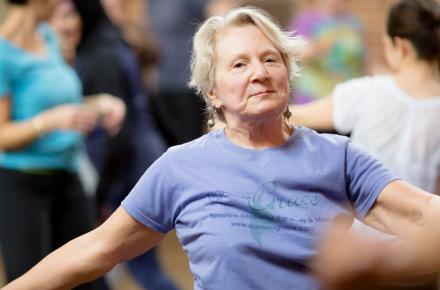A Powerful Approach to Eliciting Change: A Q&A on Motivational Interviewing with Dana Sturtevant

Dana Sturtevant, MS, RD, is a trainer, mentor, and dietitian who has facilitated more than 300 workshops on Motivational Interviewing for healthcare providers looking to enhance their skills in behavior-change counseling. She is also a Kripalu Yoga teacher who incorporates mindfulness and self-compassion practices into her work. In this Q&A, Dana describes how Motivational Interviewing works, why we don’t change when people tell us to, and where MI and yoga philosophy overlap.
What is Motivational Interviewing?
Motivational Interviewing (MI) is a person-centered, guiding method of communication and counseling to elicit and strengthen motivation for change. This methodology has been around for more than 40 years. Its two founding authors are clinical psychologists William R. Miller and Stephen Rollnick, who were working in the addictions field and were becoming dismayed with the traditional approach to people with drinking problems. They found it condescending and authoritative—the belief was that you needed to get in people’s faces and tell them they’re in denial, threaten them, and try to use logic to make them change. Instead, Miller started asking people what they thought about their drinking, how it impacted their relationships with their family and loved ones, asking them evocative questions to draw out their motivation and elicit what we now call “change talk”—statements that the client makes in support of change.
What typically happens in healthcare is that providers take the side of change, and then the client responds by talking about the other side of their ambivalence—why they can’t and won’t change. If a healthcare provider is talking about the benefits of change and the client is primarily giving voice to the downside of change, and why it’s so hard, they’re literally talking themselves out of change. A lot of healthcare providers are trained to believe that knowledge is what changes behavior, and that our job is to tell people what to do and they’ll go and do it. But there is very little data to support that. When people are told what to do, there’s a strong chance that they’re going to want to do the opposite, because people want to be in control. MI is a way of talking to people about their health and well-being and self-care that doesn’t threaten their autonomy. A huge piece of MI is that people are influenced by what they hear themselves say, not by what others say to them or how they judge them.
Take the example of flossing your teeth. Everyone knows they “should” floss their teeth every day, so when you go to the dentist and you’re told again, for the hundredth time in your life, that you “should” floss, it has very little impact on your behavior. What would be more effective is if a dentist asked you what you think would make the biggest difference to the health of your teeth and gums. You’d probably say flossing. Then they would ask, why did you pick flossing? And then you’d tell them all the reasons why it’s a good thing. When people talk about why they want to change, how specific behaviors would benefit them, it creates cognitive dissidence, and people move closer to change. It’s far more effective than traditional advice giving.
So a primary goal of MI is to elicit change talk from a client?
Yes, when a clinician is hearing a lot of change talk, vs. arguing against change, that’s a sign that what they’re doing is helpful. In MI, we pay a lot of attention to clients’ language, which tells us whether they’re moving toward or away from change. The counselor needs to be really attuned to what the client is saying, as well as the energy of the interaction. A lot of communication happens nonverbally, so we’re listening with our eyes, our ears, our hearts, to notice what’s happening. If the dynamic feels like wresting, that’s a signal that it’s more harmful than helpful. We’re looking for self-motivational statements and anything a client is saying that is in favor of making a change. This helps them sort out the conflicting thoughts and feelings they have about change.
With MI, the client has more ownership of the process, and they’re more likely to be honest and open with us about what’s really going on. If patients are censoring what they’re saying for fear of being judged, we’re not going to be able to help them because we don’t know what’s really going on. When a person feels accepted for who they are and what they’re doing—no matter how unhealthy—it allows them the freedom to consider change rather than needing to defend against it. Once a collaborative, trusting relationship is established, when we do offer advice, it’s more likely to land and be accepted.
What does the research show about the efficacy of MI?
There have been more than 70 randomized controlled trials on MI, and three out of four of those studies have shown a significant clinical effect. Overall, the data shows that some 75 percent of clients improve, 50 percent make small but meaningful changes, and 25 percent make moderate to large changes. MI seems to have an equally positive impact on psychological and physiological issues—such as cholesterol, blood pressure, how much exercise clients do, whether they stop smoking. And it can be effective in an encounter as brief as 15 minutes.
Another plus with MI is that interactions feel better to both the clinician and the client. People actually look forward to coming back to see you when you engage with them in this way, so they’re more likely to follow up in terms of visits. We see our role as exploring the possibility of change, not making it happen, and then we trust people to make the decisions that are best for them. Healthcare providers who use MI are far less likely to burn out or suffer compassion fatigue. And the literature shows that MI reduces malpractice litigation because it’s so respectful and accepting.
Besides clinicians and healthcare workers, who might find MI helpful, and what skills do they need to build in order to use it effectively?
Anyone who’s in the role of helping people change their behavior may find MI useful—career or motivational coaches, corrections officers, parents. We use the metaphor of learning to play an instrument. It’s a practice. You can go to a two-hour conference and learn about the theories and principles, or you can train extensively, as I have over the past 20 years—and I’m still learning. It’s a deceptively simple approach.
We also use the metaphor of dancing vs. wrestling to describe encounters with clients. When you’re wrestling, it implies that someone is going to win. Dancing implies a partnership, a collaboration between two experts. The healthcare practitioner is the leader in that dance—we have a sense of where we’d like to guide people, and we’re listening to them and moving forward as they are ready. We’re not trying to manipulate or persuade people, but rather to work with them to call forth their own motivations, reasons, and strategies for making change.
For example, if you have a client who would benefit from lifestyle changes to help lower their blood sugar, you don’t start by talking about all the ways to manage blood sugar. You start by asking them what it has been like to receive this information about their health, and explore their personal motivations for getting healthier. They might say, I’m tired of feeling like crap all the time, I really want to be able to walk my daughter down the aisle when she gets married, or I want to see my grandchildren grow up, or play in the family Thanksgiving football game. They connect it to their core values, the things that are important to them, and they start looking at how their behaviors are getting in the way of what’s important to them.
In yoga, we often talk about “meeting people where they are,” on or off the mat. Are there places where MI and yoga overlap?
I did yoga teacher training at Kripalu in 2002, but when I was first trained in MI in 1999, I was a yoga practitioner, and I thought this approach fit so well with yoga philosophy. It’s a very mindful practice to listen to people and notice their body language, not just what they’re saying, and also to listen inwardly and notice your own reactions to what they’re saying. There are times when I might have an emotional reaction or want to try to “fix” the client, and mindfulness can help me notice that instinct and not act on it, and instead respond in ways that are more supportive and helpful. Our job is to ask the questions, not to give the answers. Like yoga, MI is a way of getting more familiar with your inner world and understanding yourself better. It’s a process of inquiry that we’re assisting in, giving people the support to tap into their own wisdom and the answers that are already within, just waiting to be explored with the right person.
Find out about upcoming programs with Dana Sturtevant.
© Kripalu Center for Yoga & Health. All rights reserved. To request permission to reprint, please e-mail editor@kripalu.org.

















































